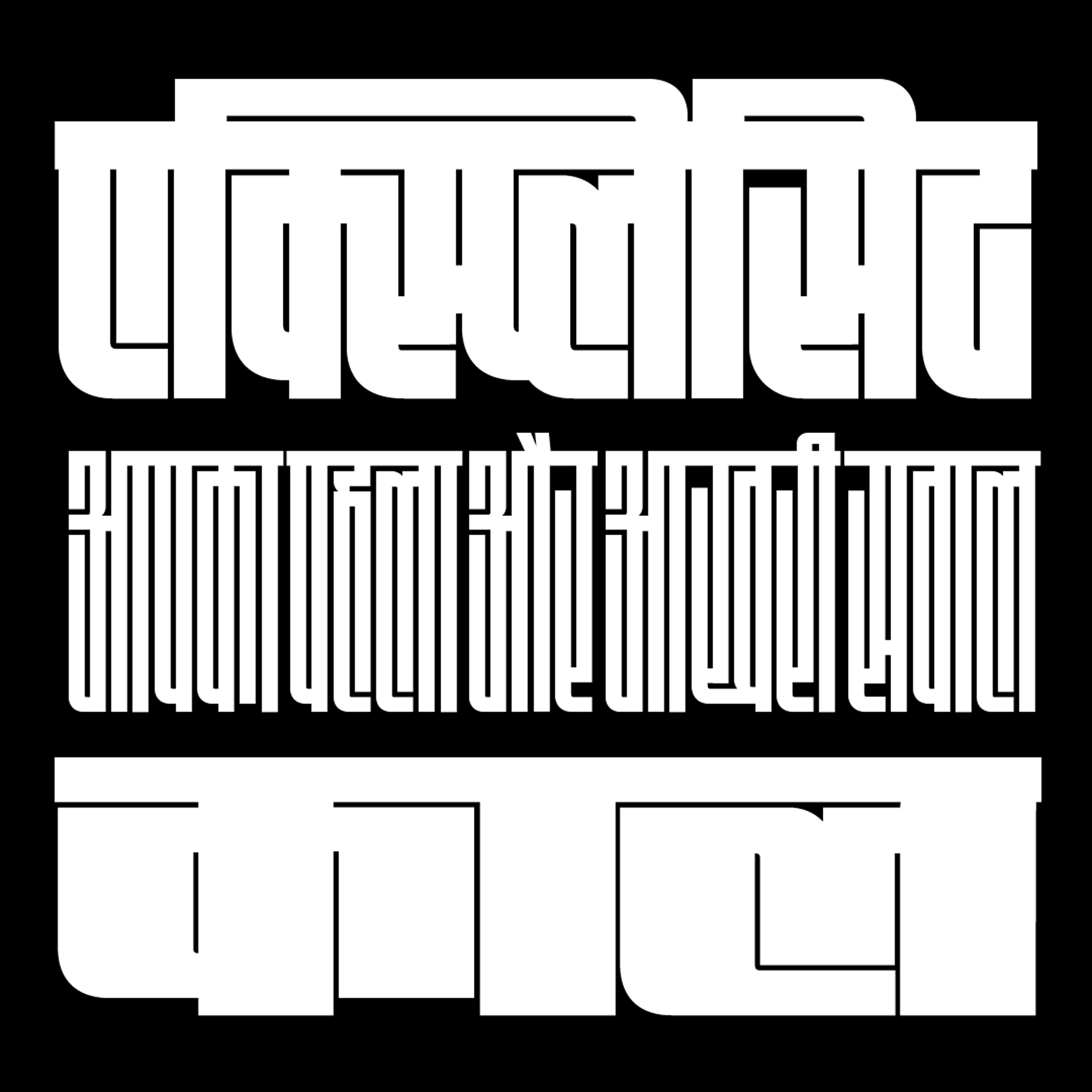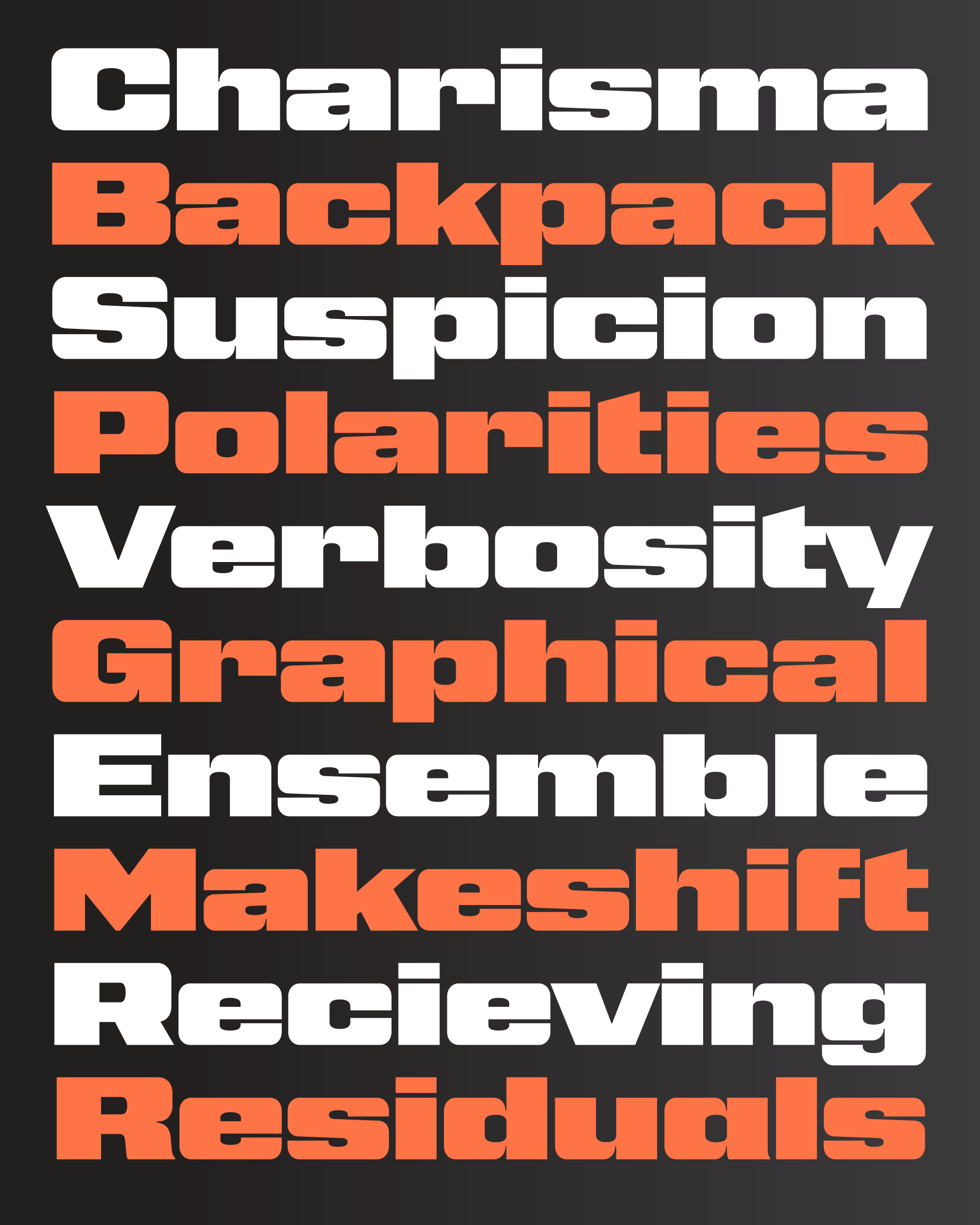Fit Devanagari Process piece
Kimya wrote a fantastic piece about the process of making Fit Devanagari...I encourage you to give it a read!
Kimya wrote a fantastic piece about the process of making Fit Devanagari...I encourage you to give it a read!

I am excited to announce Fit Devanagari, designed by Kimya Gandhi.
Fit is a blocky display sans-serif that is designed to fill space with maximum impact. Its comes in an agonizingly wide array of widths (and a variable font). This gives Fit the ability to squeeze just about any text into just about any space, forming an intricate maze of positive and negative shapes in the process.
With Fit Devanagari, Gandhi takes this concept to new heights of labyrinthine complexity. She had the difficult task of finding abstract shapes in letterforms that maintain a close connection to calligraphy, and then executing them in a way that maximizes their recognizability as well as their graphic impact.

Fit Devanagari is the latest of a series of script expansions for the typeface. Fit’s original release in 2017 supported typesetting Latin, Cyrillic, and Greek scripts, and it was later expanded into Fit Hebrew by Oded Ezer in 2018 and Fit Armenian by Gor Jihanian in 2019.
Using their combination of squares and curves as a jumping-off point, Gandhi carefully constructed a distinct vocabulary of shapes for the Devanagari, with a powerful top line (shirorekhā), swooping curves in the lower-left, and a dazzling array of divets and intersections needed to express the hundreds of complex conjuncts that are part of the Devanagari script.

There are relatively few Indic typefaces that reach this design’s extremes of weight and width, that engage with stark geometry so directly, and that utilize Variable Font technology so dramatically. For these reasons, and so many others, I hope you find Fit Devanagari to be a worthy contribution, and a powerful tool for posters and titles.
Fit Devanagari is available for purchase directly from its designer over at Mota Italic (you’ll also find it included in my Fit offerings as well). And I encourage you to browse its specimen page and PDF specimen as well!

I had the privilege of participating in the Dinamo Type Foundry Survey, where the folks at Dinamo asked some really thoughtful questions about the type biz and generated some refreshingly frank discussion from my colleagues about what’s involved in running a type foundry today.

One of my favorite bits of film jargon is “the Heavy”, a term that refers to the central villain of a story. Sure a villain can be physically large, but in my understanding, the weight of the Heavy is more metaphorical. It describes an antagonist whose mere presence is so forceful and looming that it casts a shadow over the events of the film—a shadow that propels the story as the hero fights to get out from under it.
Nickel Gothic is bold, but it isn’t the boldest or widest font in my library. However, it has a singular presence, with square shoulders and a lumbering heft that makes you think that no font could possibly be more imposing. Every letter lands on the page with a resounding thud.

This month, I was in need of a palette cleanser. Two months of Warbling involved so many little tweaks, optical corrections, and harmonizations, that my brain was fried. I needed to work on something where I could work fast, where every move I make could be big and unsubtle, and where there was no need to get bogged down in manicuring and fine-tuning. And there’s no better way to reset than to make a blocky or modular font.
So I went back into my archives and dusted off Nickel Gothic Wide, an all-uppercase sans serif that I drew back in February 2019. It was based on some small capital letters found on a Chinese banknote from 1918 that I saw in a New York Times article about the design of money. (Thanks Mom for sending me that article!)
The first thing I did was add a lowercase, figuring it would make the typeface that much more versatile. Fortunately for me, Nickel Gothic’s capital G is bearded, which creates a little divot on the bottom right of the glyph. This shape was outlier in the original caps, but it ended up being a foundational part of the entire lowercase. I love when I can borrow something from the existing vocabulary of a typeface rather than having to come up with something new.

Then, I tried my hand at a narrower width where the capital letters are closer to a square. This style starts to play in the same sandbox as designs from the ’70s like Neographik and Serpentine. I leaned into this vibe by tightening up the letter-spacing across the family, which I hope makes Nickel Gothic better suited to headlines with upper-and-lowercase settings. (You can always add a bit of tracking to the caps if you want.)
We’ve seen a resurgence of high-octane sans serifs in recent years—Conductor, Tempel Grotesk, Review, and Mortier to name a few. What sets Nickel Gothic apart is its approach to “round” shapes like O: there is a tension between the flat tops and bottoms of the exterior shapes and the rounded tops and bottoms of the counterforms. This forces the corners of the letters to get thicker than they typically would, essentially acting as shoulder pads that give Nickel Gothic its extra strength and heft.
Maybe this is pushing my metaphor too far, but I kinda like the idea of casting typefaces in a project like they are roles in a film. You might need a relatable protagonist that caters to a wide audience, but a Heavy doesn’t need to do that. The Heavy’s job is to create intrigue and tension, and I wonder if this tension is missing in too many contemporary type palettes. Without something to resolve, it’s hard to tell a good story.


The moment I sent out last month’s mailing about Warbler Text, I started to feel self-conscious. I was happy with how the typeface came out, but I had only tested it in a very specific setting (20px running text, on screen), and I started to wonder about how it would fare in other, larger contexts.
Scalability is one of the primary attributes of a digital font, but things can get awkward when the desire to make type big bumps up against typefaces that weren’t meant to get big. Feeling a bit mischievous, I hacked around with a variable font that forces Warbler to stay below 15pt. This is a bad idea for the record, and what I should have been doing is channeling that momentum into a true cut of Warbler for large sizes.
This club is all about variety. I like to mix it up and usually I wait six months or a year between sending out variants of the same family. But I hope you’ll bear with me, because this month I’m breaking my own rule! Here is my progress on Warbler Banner.

I’m actually including a few new styles of Warbler: a 96pt Banner cut for massive titles, a 48pt Display cut for headlines, a 24pt Deck cut for subheads, and a variable font that encapsulates all the space between Banner and Text—those point sizes are just suggestions. These are still very much in-progress (as far as I was able to get in the short month of February), and I imagine the design will continue to change as I adapt the small caps and Italics from the Text version and add a Bold in the future.
I’m still on the fence about whether it’s more effective to derive a display cut from a text cut, or vice versa. My own library is split: Roslindale and Forma started as displays, so I had my full range of expression to explore their personality and flavor before taming them for smaller sizes. Meanwhile, Gimlet and Fern began as small-size cuts, so I could focus on making sure they had good bones before spending any time polishing up the fancy little details.
If Forma is my most subtle take on optical size, Warbler is probably my most extreme. The x-height gets noticeably smaller, ascenders and descenders get noticeably longer, proportions get noticeably narrower, and the thick/thin contrast gets not-just-noticeably but dramatically higher.

The trouble is, the more contrast I add, the sharper the serifs get and the more I start to lose that lighter touch that I loved so much about the types that William Martin cut in 1790. It starts to feel more like a Modern than a Transitional, so I did what I could to counteract this and preserve Warbler’s delicate nature. It’s a display cut, so I want it to sparkle—the trick is to make it sparkle in a way that’s not flashy.
I played a lot with Warbler’s line quality to “slow down” the typeface so it feels more brittle and elegant than it does forceful or dynamic. Curves and bends don’t go directly where they need to go, but meander a bit instead…see the bottom of e or the shoulder of n. Ball terminals and vertical serifs are a little smaller than I’d usually make them. The proportions are a little irregular, retaining Martin’s wide L and T. And letters like a, g, and t are allowed to lean, adding a little wobble to the “picket fence” of vertical stems.

Looking back at William Bulmer’s title pages from the 1700s and 1800s, I saw that the letterforms aren’t the only thing that exercise restraint: the entire typographic palette has a distinctive lightness of touch. Everything is nice and airy, with plenty of margins and letterspacing, and absolutely no sign of borders, ornaments, or even lowercase! (Contrast this with the decorative showings of Benton’s twentieth-century revival.)
In the typographic vacuum of these title pages, size becomes *the* crucial element of the visual hierarchy. So even though the Warbler family is far from complete, I like that there is precedent for achieving great results with a limited palette. Our contemporary typographic environment is far less restrained, but I hope that Warbler can help you find moments of quiet in your typography, and new ways to use optical sizes in your designs.